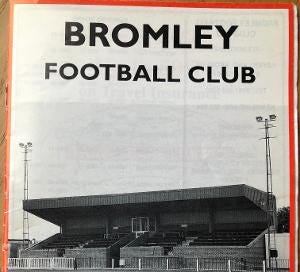If you weren’t watching Isthmian League football in 94/95, it might be hard to believe that the following actually happened. I assure you it did.
For one season only, the league agreed to an FA trial of ‘kick-ins’.
This little tweak to the laws of the game gave players the option of taking a kick-in instead of a throw-in. The kick was treated as a throw-in. While you couldn’t score directly from it, players could not be offside when receiving the ball.
The new rule was supposed to encourage attacking play and increase goal-mouth incidents, but clubs quickly worked out that if you filled your team with 6ft-plus giants, you could use any restart within 70 yards of the goal as a dangerous set piece.
As a result, Isthmian League games became a 90-minute series of set pieces and goalmouth scrambles. Initially, there were a few teams who refused to use kick-ins, sticking to football’s traditional principles instead. But as time went on, the majority of clubs embraced the route-one game plan that the new rule encouraged.
Bromley manager George Wakeling saw his team challenge near the top of the table for the majority of the season, helped by the superb set-piece delivery of Joe Francis and the aerial prowess of strikers Carl Richards, Micky Brown, Trevor Aylott, and Richard Cherry.
In a home fixture with Molesey, Joe Francis scored, or was directly involved in, three goals in the space of five minutes as Bromley won 4-3. One of those goals saw Joe drive the ball straight towards goal from a kick-in. If the Moles’ keeper had left it, it wouldn’t have counted. But, while attempting to tip it over the bar, he pushed the ball into the roof of the net for an own goal!
Another incident that is carved into Bromley folklore happened away at local rivals Sutton United.
With the game tied at 1-1 in the final few minutes, Bromley were awarded a penalty. When Richard Cherry’s spot kick was saved, a Sutton defender hoofed the loose ball into touch. That was surely that. However, without missing a beat, Joe Francis fired a perfectly weighted kick-in back into the box. His delivery found Cherry, who was still standing distraught on the penalty spot. The striker looked up just in time and headed the ball over the stranded Sutton keeper to make it 2-1 to Bromley. When the final whistle blew a few minutes later, the Ravens’ travelling support went crazy behind the goal. What had we just witnessed?!
Clubs in Bromley’s league became so tactically reliant on kick-ins that they struggled to adapt when playing in cup competitions where the rule didn’t apply. Bromley entered six cup competitions that season and were punted out of all of them early-doors. They exited the FA Trophy, Kent Senior Cup, Club Call Cup, and Diadora League Cup at the first time of asking, and departed the London Challenge Cup in their second game, losing 6-4 away at St Albans City. In the FA Cup, the Ravens beat Bognor Regis Town 3-2 at home, but lost a replay 1-0 to Gravesend & Northfleet. It was not a cup season.
ISTHMIAN PREMIER DIVISION
The biggest home gate of 94/95 came on Boxing Day when 916 watched second-placed Bromley lose 2-0 at home to Dulwich Hamlet. Hayes Lane’s lowest league attendance saw 253 hardy souls brave the pouring rain for a mid-week 6-0 loss to bottom-of-the-league Marlow at the end of March. With standing water all over the pitch, the game should never have been played, but the referee insisted it was fine and the visitors adapted far better to the conditions.
Bromley’s traditional post-Christmas slump saw their title challenge fade away, though they secured sixth place with a decent end-of-season run. The highlight of that run was a 5-0 win over Walton & Hersham, with goals from Mickey Brown (2), Pat Gordon, Keith Sharman, and Frank Coles. Club legend Coles was among a select group of players who played over 40 games in what turned out to be a 52-game season. Carl Richards, Andy Salako, Dean Francis, Ollie Adedji, and Keith Sharman all joined him in that club. Joe Francis finished the season as top scorer.
Unsurprisingly, the kick-in experiment only lasted one season. The blazers at the FA soon realised that it encouraged teams to bypass the creative engine of the midfield, which was an anathema for football purists. For the likes of myself, who like the rough and tumble of lower league football, it was a lot of fun, but we all knew it wouldn’t last.
Enfield won the league but were turned down for promotion due to their unsure financial footing. Runners-up Slough Town took their place in the Conference (now the National League). Chesham, Marlow, and Wokingham were relegated to Division One.
Thirty years later, with their inaugural season in League Two just months away, Bromley are the highest-placed team in the class of 94/95. Wokingham and Molesey meanwhile have slipped furthest down the pyramid, finding themselves in the Combined Counties League.
Some of the clubs no longer exist. Enfield split into two teams at the start of the 2000s, Hayes & Yeading merged in 2009, and Purfleet changed their name to Thurrock before eventually folding in 2017.
It’s a funny old game.
Thanks for taking the time to read the article - you can expect more like this as well as videos, audio posts, interviews etc etc
You can find Colin Head on Twitter - here
All articles are edited by Peter Etherington you can link to him here
If you havent as yet make sure you read the other articles in the archive.
If you’d like to show an appreciation for the work that goes into this newsletter you can buy the team a coffee through the link below.
Most importantly of all subscribe to the newsletter to ensure you get these updates direct to your inbox.







Another excellent article. That was my first season, and the boxing day 1994 home match 2-0 loss to dulwich was my first ever game, with my dear old Dad and his mate Derek Dobson (one of the original bromley boys). Some good players, Keith Sharman in particular.
Great article as always!